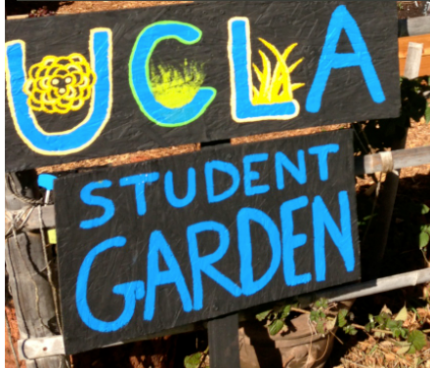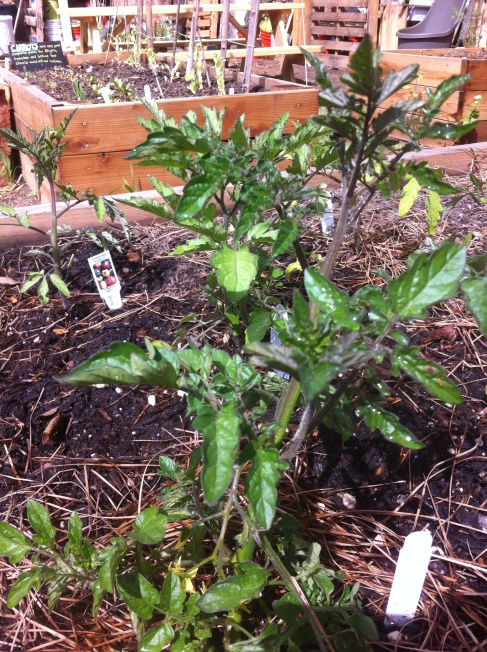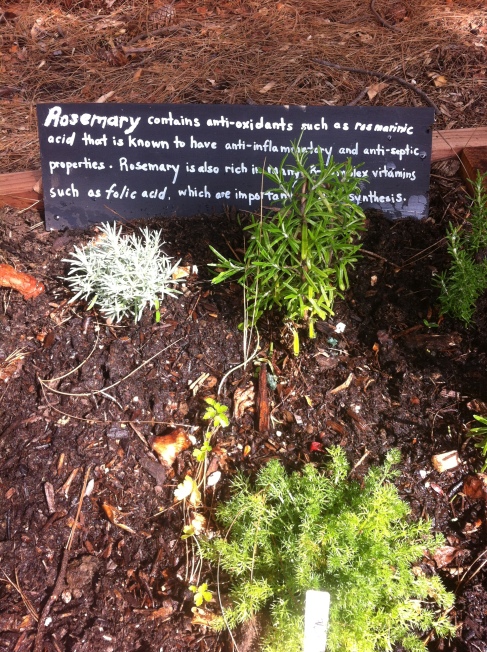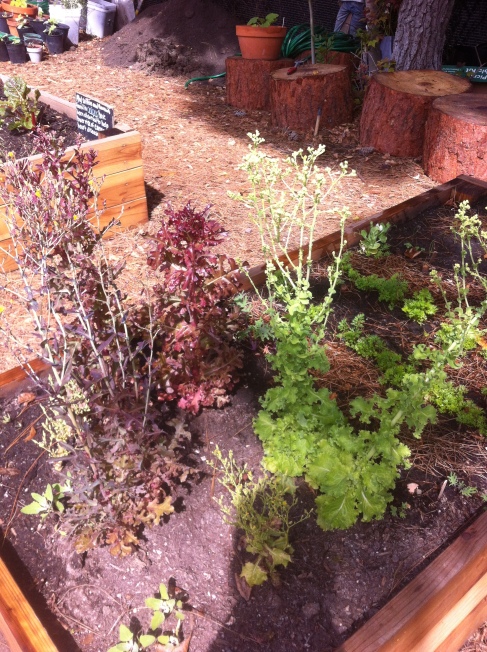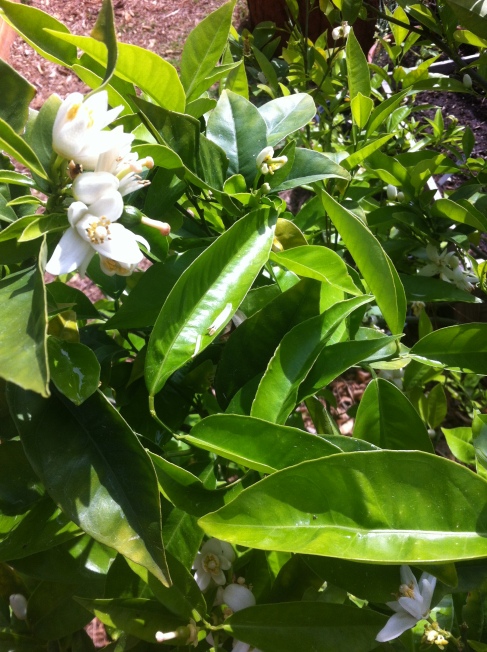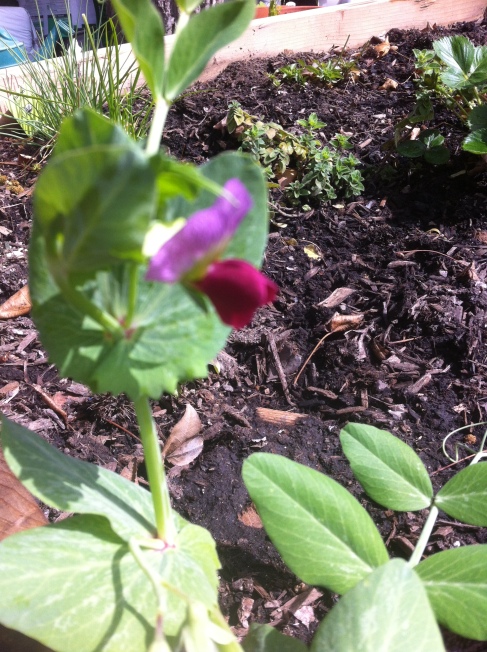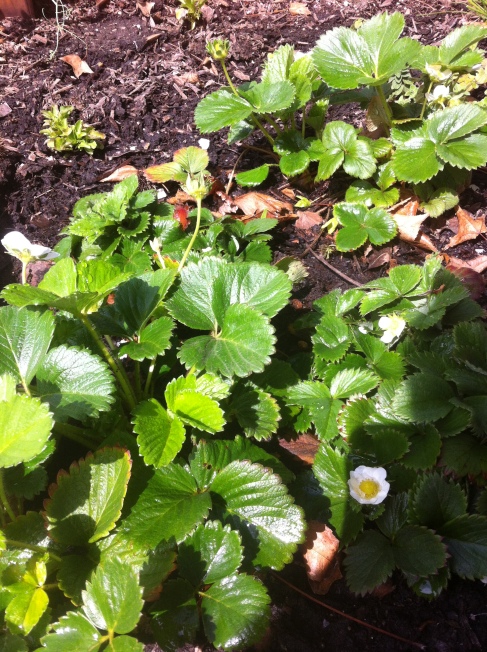Book Review: Grow More Vegetables (Grow Biointensive) By John Jeavons
Posted: March 22, 2013 Filed under: Book reviews | Tags: biointensive, compost, john jeavons, mulching Leave a commentJohn Jeavon’s How to Grow More Vegetables is not just a detailed manual for gardeners but an exposition of a style of gardening which breaks the norm from organized gardening. Jeavons uses soil science to explain how plants can benefit from being grown in closer proximity than is usually accepted. He points out that by growing plants close together you can reduce the amount of water and soil lost by evaporation and wind as well as being able to use less land for agriculture. Jeavons acknowledges that some soil and nutrients will always be lost though while gardening and thus a gardener must be constantly building up his soil by composting items which are grown in the garden (as well as compost from outside). In this way a plant which drew up nutrients from the soil will be broken down during composting and it’s nutrients released back into the soil for other plants to absorb.
The book contains many easy to replicate methods for different types of composting for different environments. He also provides information on compost makeup as well as dos and don’ts of composting. In the back of the book are extensive lists of pant rotation charts, plants which benefit each other when grown near each other and other companion planting advice.
Jeavons calls his methods Grow Biointenstive, and claims that they are more sustainable than most current gardening practices. One of the methods he claims to have invented is a method of double digging in compost to soil. In this method the compost is easily interspersed into the soil by use of a shovel with the least amount of digging necessary, something that anyone who has dug holes can appreciate. I recieved this book a few months ago and have very much appreciated looking through it and have learned a lot of useful information.
Black Rice by Judith Carney
Posted: March 22, 2013 Filed under: Book reviews Leave a commentby Ellen Bastrmadjian
“Black Rice” is a poignant retelling of the origins of one of the most critical crops in America today. Contrary to popular belief, rice was not introduced to the Americas by European settlers and slave traders, but by the slaves from West Africa. On the African continent “The Rice Coast,” which spans from Senegal in the north to Liberia in the south and east to Mali, is where rice has traditionally been grown for over two millennia. Carney begins by presenting historical evidence that cites rice cultivation in Africa through documents written by European explorers. She then delves into the history of rice cultivation in Africa, detailing landscape and climate conditions, specialized tools, and traditional gender roles. Carney switches gears and begins to discuss the introduction of Oryza glaberrima, or African rice, into the Americas – namely what is today South Carolina, where rice production was highest. She attributes this production to the indigenous African knowledge system, possessed by women in particular, that was transferred through the Middle Passage. She discusses the similarities in rice cultivation between the Rice Coast and South Carolina, such as similar gender divisions and climate/landscape conditions. Lastly, she presents her main argument, which is that rice was introduced by African slaves and discusses the legacy of that cultivation in the Americas of returning to Africa after slavery was abolished.
Judith Carney is a distinguished professor of Geography at UCLA. Her interest in the agricultural exchanges during the Columbian period and beyond influenced “Black Rice” – expanded from several published articles.
Carney has substantial evidence to back her claims with a range of information from primary documents to scientific and technical information. The wide range of evidence definitely legitimizes and makes the information interesting. She presents additional evidence and information through photographs, diagrams and maps. The unexpected visual aspect compliments the text perfectly and piques the reader’s interest in the subject. Carney’s emphasis on women’s role in the history of rice cultivation is refreshing in a field where contributions made by members of the female sex are typically overlooked in a historical context.
Carney recognizes the significance of food, which according to her, is not merely a form of sustenance but a form of cultural expression and identity. For example, she argues that the proper preparation of rice was created by African women. It is a history that is very much entwined with several other histories – slavery, the New World discovery, white supremacy, etc. Carney effectively contextualizes all of these aspects and turns something as simple as the introduction of a species on a new continent into a compelling tale.
The book is well-written and contains interesting and novel information, however, it becomes repetitive as the same information is stated several times. Facts such as slaves being able to barter a shorter work day by offering cultivation knowledge of rice and the conditions of rice cultivation are mentioned several times, using identical wording. If you are deeply interested in the exchange of rice from one part of the world to the other and all of the social, cultural and economic implications of that exchange I would recommend this book. If not, it might be easier to read the several published articles Carney has written about the topic for a more concise overview of the topic.
Carney, Judith Ann. Black rice: the African origins of rice cultivation in the Americas. Cambridge, Mass.: Harvard University Press, 2001. Print.
The garden could use your help.
Posted: March 22, 2013 Filed under: UCLA E3 garden collab Leave a commentSpring break is right around the corner, a time for many to get away from campus, leaving us in a need of volunteers the week of March 24th-29th to water the fast growing plants at the Student Garden at Sunset Recreation Center. Mornings are best to water, though we would be appreciative for any time as long as it gets watered. *1-2 volunteers per day needed*. Water sufficiently, but avoid puddles! Please visit the sign up sheet or email Alyssa at aac1218@gmail.com if you are available and would like to volunteer. Email for any questions! Thank you!
Book Review: The Urban Homestead
Posted: March 22, 2013 Filed under: Book reviews | Tags: Book review, local producers, urban agriculture Leave a commentIn their book The Urban Homestead: your guide to self-sufficient living in the heart of the city, authors Kelly Coyne and Erik Knutzen challenge your concepts of the urban household. The book is a how-to guide on living in a self-reliant and resource-conscious manner, suggesting ways to live sustainably, ranging from fermenting one’s own beer to keeping chickens as pets to pooping in a bucket for compost. Not only is it a practical guide, providing projects that one can take on, but it also instills a sense of excitement in the reader about reconnecting with the natural world. Urban homesteading involves appreciating the beauty of natural processes, such as the creation of nutrient rich soil from food waste via decomposition, and the appreciation of the quality, such as that of one’s home-grown fruits and vegetables that isn’t afforded by supermarket varieties. “Urban homesteading is an affirmation of the simplest pleasures of life,” Coyne and Knutzen write. “Homesteading hooks us into the natural world and the passing of the seasons, and reminds us of our place within the greater cycle of life.” (pp 17)
The book’s main sections provide background and information on how to farm, forage, raise livestock, transform and preserve food, sustainable manage water and power use, and sustainably use transportation. A number of themes run throughout these sections, most notably sustainability and self-sufficiency, biomimicry, and utility.
The authors strongly advocate for sustainability and self-sufficiency in this book, breaking away from the traditional capitalistic material consumption and resource overuse. Coyne and Knutzen put forth the idea of a “new urban economy” where individuals are conscious of resource consumption and the environmental impact of their lifestyle, and there is an interchange of goods and services within a community that understands that “there is more power in creating than spending.” (pp 16) The section on water and power also provides how to’s on water harvesting and reuse, and power generation and conservation. The section makes readers rethink how they use and value these resources, and gives them a way to efficiently use them.
Biomimicry, or modeling something based on natural systems, also has a strong presence. These systems often involve natural symbioses, interdependencies, cycles, and closed loops. The gardening section introduces permaculture, which is agriculture designed based on a sustainable human environment. The process involves engineering agricultural practices based on natural interdependent systems processes, such as crop rotation based on the nitrogen fixing or consuming nature of plants, or the physical protection from harsh sun or rain afforded by larger plants to smaller plants, or one plant’s attraction of beneficial insects which prey on pests that infect other plants. Mulching is another exemplary case of biomimicry suggested in the farming section. This process involves the layering of leaves and compost which imitates the natural deposition of material that occurs in an ecosystem, such as a tree shedding its leaves, a dying plant decomposing, and a native animal pooping. These, and a number of other processes that the authors describe use natural processes to help the urban homesteader create sustainable, symbiotic systems. It is a stark contrast to today’s industrial agriculture which refutes natural principles, intensively extracting soil nutrients to create produce which is transported across the country and results as waste in landfills where rather than returning to the soil it came from to replenish the soil health.
Lastly, utility is a huge component of the book. The first of Coyne and Knutzen’s principles is “grow only useful things.” “Water is a resource. Time is a resource. Space is a resource. We no longer squander these resources on merely decorative plants.” (pp 34) Though this may be a point of contention with some, particularly the urban resident whose ideal garden consists of a yard of grass lined with roses and a white picket fence, it is a sensible rule nonetheless. Not only do Coyne and Knutzen describe the productivity of plants, but they elaborate on the productivity of owning livestock. “Your household produces food waste. Farm animals eat this waste and make fertilizer out of it, accomplishing overnight what would otherwise take weeks of decomposition in a compost pile.” (pp 132) The couple also challenges our idea of raising animals for slaughter ourselves, pointing out that we are so disconnected with our food sources that the slaughter of animals is shocking, yet chickens you raised yourself are the most sustainable and humane meat you can get.
The guide concludes by expressing a hope for a “consciousness shift” in the public, where city dwellers become more connected and aware of their resource use, and embrace urban agriculture and sustainable homesteading. The fascinating and innovative how-to’s that the authors provide are not only practical, but they push our boundaries of what we consider a “normal” household. This couple truly is pioneering a consciousness shift, and the reinvention of the urban dweller as a resource-conscious and self-sufficient urban homesteader.
-Maya Bruguera
Review: A Place at the Table
Posted: March 22, 2013 Filed under: Book reviews, Documentary, Films and Video | Tags: a place at the table, documentary, food desert, food insecurity, hunger, review Leave a commentA Place at the Table. Dir. Kristi Jacobson and Lori Silverbush. Perf. Jeff Bridges, Tom Colicchio, Ken Cook. Participant Media, 2012. Film.

Made by Participant Media, the same company that produced 2008 film Food, Inc., A Place at the Table creates a clear picture of hunger and food insecurity as it exists today in America. It investigates a handful of today’s 50 million incidents of food insecurity, working to dispel the myth that hunger is reserved for those who are literally starving, and proposes solutions which center around government and policy changes.
The film is similar to Food, Inc. in that its main drive is in-depth storytelling of individuals and families. Unlike Food Inc., however, it is not broken up into themed chapters. Instead, these individuals and families reappear in a non-linear fashion, contributing to each others’ stories in order to add to themes which weave throughout. These characters include Barbie Izquierdo, Philadelphia single mother of two (one of whom has various health problems) who depends on SNAP and struggles to find a job, only to lose her benefits when she finally finds a job; Colorado 5th grader Rosie, who cannot focus in school because she often goes hungry, relies on community resources, and hopes her kids will have a better life than she; and Tremonica, an obese, asthmatic, and diabetic Mississippi child who embodies the effects of her state’s notoriously calorie-dense, nutrient-deficient diet. The film follows these characters throughout the country to reveal food insecurity’s main causes (lack of access, lack of money, lack of education and prohibitive or counterproductive government policies) and effects (hunger, malnutrition, stress, depression, humiliation, obesity, learning disabilities, diabetes).
Other characters are highlighted to convince the viewer that government intervention is necessary, by highlighting that these characters can only do so much, and especially within a system that works against them. Barbie’s confidant, as well as doctor and fellow “Witnesses to Hunger” advocate, Mariana Chilton, brings Barbie to Washington, explaining “these guys are the ones who make it happen.” Rosie’s Pastor Bob Wilson runs a soup kitchen, yet sees that the need is greater than what he is able to supply. Finally, Tremonica’s teacher Odessa Cherry teaches her enthusiastic 2nd graders about fruits and vegetables, but cannot help parents who work with a limited budget and whose dollars go further when buying junk food than produce.
Narration, info-graphics, and commentary add to the film’s message that alternative aids are meant to be emergency resources, and that government and policy change are the only realistic means for ending food insecurity. Occasional narration guides and offers clarification or shocking facts when necessary (example: 23.5 Americans live in food deserts, 75% of which are urban; 70% of USDA subsidies go to 10% of its beneficiaries, and only 4% are for fruits and vegetables). Interjections by authors, activists, politicians, doctors, chef Tom Colicchio and actor Jeff Bridges offer insight on characters’ first-hand experiences, often allowing the viewer to gain greater meaning from them (Ex: One commentator explains that 85% of poor Americans have at least one job). Animated info-graphics offer a timeline of hunger in America, revealing to the viewer that hunger, obesity, and food insecurity is not a new problem, but that it was almost solved in the 1970s until Reagan’s tax cuts and military spending.
A Place at the Table creatively traces the leading causes of food insecurity, examines the health-related repercussions and emotional toll of such food insecurity, and is able to convince the viewer that food insecurity is a serious problem which can, must and should be remedied through government aid. The film does a good job of finding people throughout the country with shockingly similar stories and revealing the ubiquitous nature of food insecurity. It is not overly laden with facts, but is mainly story-based. Yet it still presents a clear and credible case.
A Place at the Table had a few shortcomings. The film had a clear focus on the effects of food insecurity on children. As a result, it mostly neglected the elderly, disabled, homeless, and unemployed. This may be because it is easiest to argue that children deserve food no matter what, especially when marketing to Americans who, as one commentator explains, “have a love-hate relationship with the poor.” It was also a fairly one-sided narrative, with most commentators sharing extremely similar opinions and merely working to seamlessly reinforce each others’ views. The film left it up for no debate that governmental action is the only solution to systemic food insecurity.
Finally, my biggest problem with the film was that while it was able to draw viewers in and convince them that consumer interest and power is necessary to get legislators to act, there were no clear action steps prescribed! After empowering viewers to be the change, the film basically says “this is wrong–do something.” The final moment of the film encapsulated this perfectly, as it revealed a screen with the words “Everyone Deserves a Place at the Table” and then a number to text in order to donate $10. There was no mention of Participant Media’s website “Take Part,” which has created advocacy and education opportunities, and no simple advocacy steps to leave with. While effective in conveying a complicated issue in a compelling and easy-to-follow manner, A Place at the Table left me sad, angry, energized, and ready to fight hunger, yet without any outlet for this inspiration.
Mycelium Running: How Mushrooms Can Help Save the World
Posted: March 21, 2013 Filed under: Book reviews | Tags: Book Report Leave a commentPaul Stamets is an authority on mushrooms in the world of mycologists. He has published several books before this one, some of which define mushroom cultivation. This particular text, Mycelium Running, expands upon the practical uses of mushrooms other than as a food.
Stamets demonstrates the power of fungi in the environment through examples, many of them first-hand. Some key uses are water reclamation/filtration, land remediation, and natural pesticides.. Mushrooms provide alternatives to our current systems of caring for the environment. As water filters, fungi are inexpensive and easy to maintain. Stamets’ own farm had toxic runoff produced by his livestock. Pathogens such as bacteria and parasites entered the water supply, creating problems downstream. To solve this problem, he laid a down a bed of mushrooms in the path of the runoff. The contaminated water seeped into the bed, feeding mushrooms that preyed on the bacteria and parasites. Runoff after the mushroom filter contained far fewer contaminants than his neighbors without the mushrooms.
The use of bacteria to clean up oil spills is well known. Mushrooms are able to do the same, and more. Different species of mushrooms have different niches in the remediation department. Some consume petroleum, useful for oil spills. Others take up radioactive substances, gathering them up into their fruiting body (the mushroom). Many are able to sequester heavy metals and chemicals such as DDT in their mushroom bodies. In the last two instances, the mushrooms can be harvested and disposed of safely. This would save millions in clean-up efforts, as well as increasing the efficiency.
One of the properties Stamets once owned was infested with termites and carpenter ants. The house was falling apart, being eaten by the insects. Stamets introduced parasitic fungi selective for the termites and ants. Within weeks, the pests were gone. The insects had brought the fungal spores to their homes, infecting entire colonies.
In the book, Stamets also gives an introduction on how to start a mushroom farm. Starting from scratch, one would have to either obtain spores from the wild or spores/spawn from a commercial seller or a friend. The spores are cultivated on agar in a plate, then inoculated in a suitable substrate, such as straw or wood. Water and temperature are important factors; much like crops, different species have different ideal climates. Tender love and care result in mushrooms. Another method relies on the underground network of mycelia, the “roots” of mushrooms. They can be transferred to a garden from the wild or from another garden. After the transplant, some effort and time are rewarded with mushrooms.
Stamets devotes a large portion of the book to mushroom types and identification. This is an essential part of mushroom farming and foraging, especially when there is potential of poisonous species. Plenty of pictures help guide the reader through his or her own adventures.
I found this book to be very informative. The different ways mushrooms can be used are just amazing. With so much potential, it makes me wonder why we don’t see them used often. Stamets focuses on the uses of mushrooms on a large scale: how they can be used to mediate farms, keep pests under control, and reclaim ruined land. There is little to no mention of urban agriculture; that is a jump the reader will have to make him/herself. It was an interesting task to apply his ideas in urban agriculture. As I read his book, I had a sense that Stamets glorified the mushroom. Although I completely share his feelings, I had to take a more objective view on his work. Some of the concepts he brings up may not be feasible. For example, large farms have large wastes; how much land will it require to filter all of it using mushrooms? This is doubly true in large cities that feel cramped as is. However, part of the fun is also attempting to solve these problems.
Garden Visit 3/20
Posted: March 20, 2013 Filed under: Uncategorized | Tags: watering Leave a commentHello all! I visited the garden today to water the plants and seedlings and make sure everything was all right.
I saw that many of the tomato seedlings had been transplanted into the beds and had established themselves quite well!
I really like the addition of the educational signs about the plants growing in the garden – they have some interesting and useful info about which plants can be planted together and also some nutritional information, like vitamin content. They make the garden seem even more organized and aesthetically pleasing than it already is!
Plants are blooming and bolting and it’s all beautiful! I saw some new strawberries, many citrus blooms, baby blueberries and pea greens (those things grow fast!). Can’t wait to visit again after spring break and see the progress.
One thing that might be troublesome is all the pinecones on the ground – they make it difficult/potentially dangerous to walk around. I cleared some out of the way.
If you’re going to be in westwood over spring break please stop by to water the garden!
garden visit 3/19
Posted: March 20, 2013 Filed under: Uncategorized Leave a comment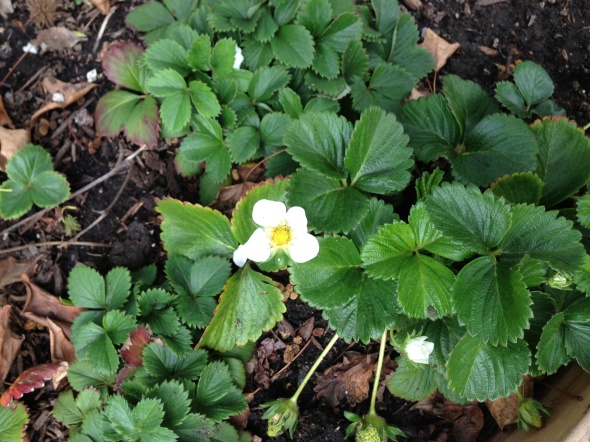
Went to the garden and again there were people just out there chilling on the table and on the grass around it. Its nice that there is a relaxing place to go that is pretty secluded and has some unique scenery to look at. I took a picture of the strawberry plant which is my favorite. Wish it would already make some more already.
Garden Visit 3/18
Posted: March 18, 2013 Filed under: Uncategorized Leave a comment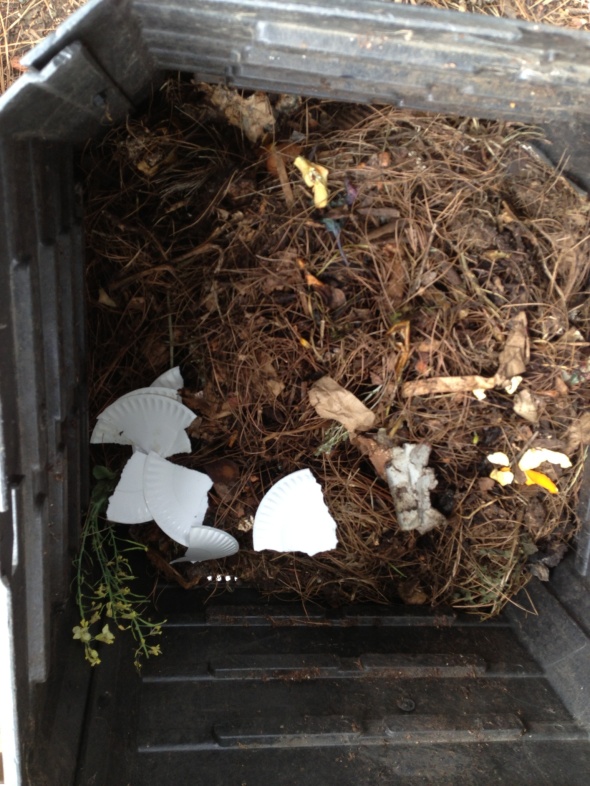
Went to the garden and checked things out. Another gloomy day but the cool weather made it nice. I turned the compost and added some water to it. There were a lot of little critters in it which was cool to see. There was also a family having a picnic by the garden and some kids checking the plants out which was fun to see.
